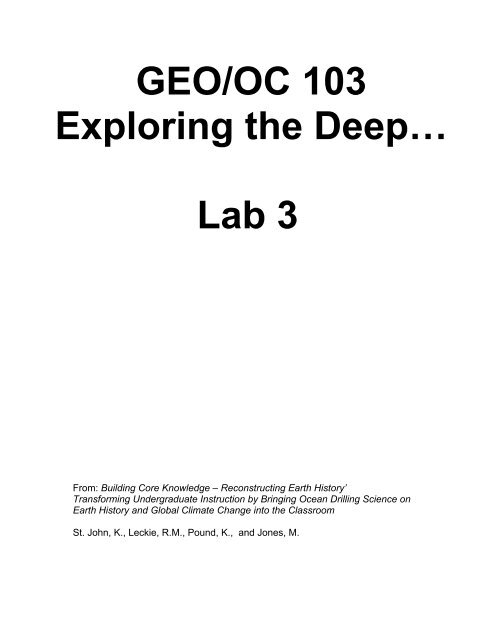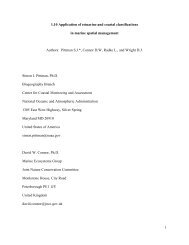GEO/OC 103 Exploring the Deep… Lab 3 - Oregon State University
GEO/OC 103 Exploring the Deep… Lab 3 - Oregon State University
GEO/OC 103 Exploring the Deep… Lab 3 - Oregon State University
You also want an ePaper? Increase the reach of your titles
YUMPU automatically turns print PDFs into web optimized ePapers that Google loves.
<strong>GEO</strong>/<strong>OC</strong> <strong>103</strong><br />
<strong>Exploring</strong> <strong>the</strong> <strong>Deep…</strong><br />
<strong>Lab</strong> 3<br />
From: Building Core Knowledge – Reconstructing Earth History’<br />
Transforming Undergraduate Instruction by Bringing Ocean Drilling Science on<br />
Earth History and Global Climate Change into <strong>the</strong> Classroom<br />
St. John, K., Leckie, R.M., Pound, K., and Jones, M.
Name_____________________________<br />
Intro to Cores<br />
Part 1. Earth History Archives<br />
1. (a) What are sediments Give two examples.<br />
(b) What are <strong>the</strong> sources of sediment Make a list.<br />
A<br />
B 2<br />
B 1<br />
Figure 1.1. Major sedimentary depositional systems. Drawn by Lynn Fichter (James Madison<br />
Univ.). A = example outcrop setting, B 1 = example of a core in a marine (ocean) setting, B 2 =<br />
example of a core in a terrestrial (land) setting (see related Fig 1.2.).<br />
2. Examine <strong>the</strong> block diagram above (Figure 1.1). Where do sediments<br />
accumulate Why do <strong>the</strong>y accumulate here<br />
Page 1 of 3
Name_____________________________<br />
Examine <strong>the</strong> outcrop and core photos shown in Figure 1.2. These could have<br />
originated from locations A & B 1 , respectively, in <strong>the</strong> block diagram (Figure<br />
1.1.)<br />
Figure 1.2. A. Outcrop (above) from Bastrop, TX (photo courtesy<br />
of John Firth, IODP). B. A 104-cm long section of a marine core<br />
(right) recovered from drilling <strong>the</strong> Pacific Ocean sea floor. The core<br />
is ~7 cm wide; it was originally a cylinder that was cut in half<br />
lengthwise.<br />
3. What do you observe in <strong>the</strong> outcrop in <strong>the</strong> core<br />
Outcrop observations<br />
Core Observations<br />
4. In 2 or 3 sentences explain how outcrops are similar to cores and how <strong>the</strong>y<br />
are different:<br />
Page 2 of 3
Name_____________________________<br />
5. If you were asked to collect samples (get a piece or handful) of <strong>the</strong> oldest<br />
sediment in <strong>the</strong> outcrop and <strong>the</strong> oldest sediment in <strong>the</strong> core, where would you<br />
get it from Place an “X” on <strong>the</strong> outcrop photo and a “Y” on <strong>the</strong> core photo<br />
indicating your selections (Fig. 1.2). Explain why you selected <strong>the</strong>se locations.<br />
6. What characteristics would make a sedimentary sequence useful as an<br />
archive (record) of Earth’s past environmental and climatic change Do<br />
outcrops have <strong>the</strong>se characteristics Do cores<br />
7. Watch a 5 minute video on ocean drilling. Go to:<br />
http://recordings.wun.ac.uk/conf/nwo/oceandrilling2006 and select “Why<br />
Ocean Drilling”. Imagine you have to reconstruct Earth history for <strong>the</strong> last 5<br />
million years as completely as possible. Which would you choose to use: an<br />
archive from <strong>the</strong> seafloor or an archive from land and why<br />
Page 3 of 3
Name _______________________________<br />
Intro to Cores<br />
Part 2. How are ocean cores<br />
obtained<br />
1. How might cores be obtained from below <strong>the</strong> seafloor What types of<br />
technology might be necessary to accomplish this scientific task<br />
2. Examine <strong>the</strong> photo below of <strong>the</strong> drill ship, JOIDES Resolution (Figure<br />
2.1) and <strong>the</strong> diagram of <strong>the</strong> drill ship’s coring system (Figure 2.2, next<br />
page). Watch <strong>the</strong> video “Modernization of <strong>the</strong> JOIDES Resolution Riserless<br />
Drilling Vessel” by going to http://www.youtube.com/OceanDrilling. How<br />
are vessels used for scientific ocean drilling specially outfitted to enable<br />
<strong>the</strong>m to recover cores from below <strong>the</strong> sea floor<br />
Figure 2.1. Scientific research vessel, JOIDES Resolution. For a history of <strong>the</strong> ship go to:<br />
http://iodp.tamu.edu/publicinfo/ship_history.html.<br />
Page 1 of 7
Name _______________________________<br />
Figure 2.2. (A) Schematic drawing of (left) drilling equipment on <strong>the</strong> JOIDES<br />
Resolution. The drilling mode shown is with a reentry cone used to reenter a previously<br />
drilled hole. New holes are drilled in bare seafloor without a reentry structure. (B)<br />
Schematic of <strong>the</strong> rotary coring system drilling into bare seafloor. (From http://wwwodp.tamu.edu/publications/tnotes/tn31/jr/fig_02.htm<br />
and http://wwwodp.tamu.edu/publications/tnotes/tn31/rcb/fig_01.htm,<br />
respectively.)<br />
Page 2 of 7
Name _______________________________<br />
3. Examine <strong>the</strong> map below (Figure 2.3.), which shows all of <strong>the</strong> drill site<br />
locations from <strong>the</strong> 40+ year history of scientific ocean drilling<br />
expeditions. At each of <strong>the</strong>se drill site locations several holes may have<br />
been drilled and tens to hundreds of 9.5-m length cores recovered. To<br />
more easily carry and store <strong>the</strong> cores, each is cut into 1.5-meter<br />
sections (Figure 2.4.). The core sections are also split length-wise into<br />
a two halves – a working half, which is used in sampling, and an<br />
archive half, which is used for non-destructive analyses and for core<br />
photography (Figure 2.5.). In total <strong>the</strong>re are currently >40,000 m of<br />
core recovered from below <strong>the</strong> seafloor, and >2.3 million samples taken<br />
of specific cm-intervals of <strong>the</strong> core sections. Those are a lot of cores and<br />
samples to keep organized! Librarians have much <strong>the</strong> same problem, so<br />
we will see how <strong>the</strong>y keep <strong>the</strong>ir collections organized. Let’s start by<br />
determining how geology resources are identified in a library.<br />
Figure 2.3. Scientific ocean drilling site locations of <strong>the</strong> Integrated Ocean Drilling Program<br />
(IODP; 2003-2013) and predecessor programs, <strong>the</strong> Ocean Drilling Program (ODP; 1983-<br />
2003) and <strong>the</strong> Deep Sea Drilling Project (DSDP; 1968-1983).<br />
Page 3 of 7
Name _______________________________<br />
(a) Your job is to find <strong>the</strong> following in your university library system: <strong>the</strong><br />
1987 book Glossary of Geology by Bates & Jackson (editors). How is this<br />
geology book uniquely identified<br />
(b) Now go to <strong>the</strong> U.S. Library of Congress website<br />
(http://catalog.loc.gov/) and find this same resource. How is it identified<br />
(c) Think about marine core samples - how could you ensure a unique<br />
identification for each sample so that you knew exactly where in <strong>the</strong> subseafloor<br />
it came from List your ideas. Why is a unique identification of<br />
samples important<br />
Page 4 of 7
Name _______________________________<br />
Figure 2.4. Example of coring and core terminology (from ODP Leg [i.e., Expedition]<br />
199 Initial Reports Volume, Explanatory Notes: http://wwwodp.tamu.edu/publications/199_IR/chap_02/chap_02.htm)<br />
4. (a) Expedition (Leg) 199 began in Honolulu, Hawaii on October 28,<br />
2001. The JOIDES Resolution left port at 0830 hr on 28 October and<br />
transited 1158 km to <strong>the</strong> first drilling location, Hole 1215A, arriving at<br />
2100 hr on 30 October, 2001. Calculate <strong>the</strong> average rate of travel (i.e.,<br />
speed) during transit in km/hr and mi/hr.<br />
(b) Hole 1215A was planned for 57.5 hrs of drilling during Expedition 199.<br />
During this time <strong>the</strong>y were able to drill 75.4 meters below <strong>the</strong> seafloor at<br />
this single location. What was <strong>the</strong> average drilling rate for Hole 1215A<br />
Page 5 of 7
Name _______________________________<br />
(c) While <strong>the</strong>y drilled 75.4 meters below <strong>the</strong> seafloor at Hole 1215A, <strong>the</strong>y<br />
recovered 68.27 meters of core. What was <strong>the</strong> percent core recovery for<br />
Hole 1215A Why might <strong>the</strong> core recovery be less than <strong>the</strong> maximum drill<br />
depth<br />
Figure 2.5. Photo of <strong>the</strong> archive-half of Core 2 from Hole 1215A, located in <strong>the</strong> central<br />
tropical Pacific Ocean. The sections of core are laid out next to each o<strong>the</strong>r, left to right.<br />
Section 1 of Core 2 is at <strong>the</strong> top of <strong>the</strong> drilled interval and <strong>the</strong> core catcher (CC) is at <strong>the</strong><br />
bottom of <strong>the</strong> cored interval. The shipboard paleontologists took a sample (PAL) from<br />
<strong>the</strong> base of <strong>the</strong> core catcher to provide a preliminary age determination for Core 2. Site<br />
1215 was cored during Ocean Drilling Program Leg (i.e., Expedition) 199. Note that an<br />
interstitial water sample (IW) was taken from <strong>the</strong> bottom of Section 3.<br />
(d) A typical ocean drilling expedition lasts 2 months and costs ~$6<br />
million. At Hole 1215A on Expedition 199, 68.74 meters of core were<br />
obtained during <strong>the</strong> 57.5 hours of drilling. What does 1 meter of core<br />
from Hole 1215A cost (i.e., what is its value)<br />
Page 6 of 7
Name _______________________________<br />
(e) Sometimes scientific ocean drilling and space exploration (i.e., NASA)<br />
are compared because <strong>the</strong>se are both large-scale, technologically<br />
dependent programs that are designed to help teams of scientists unravel<br />
<strong>the</strong> history of Earth by exploring in remote and challenging settings. Let’s<br />
compare <strong>the</strong> cost of obtaining core from <strong>the</strong> seafloor to <strong>the</strong> cost of<br />
obtaining rocks from <strong>the</strong> moon.<br />
The Apollo 11 mission cost $355 million in 1969. Approximately 21.8 kg<br />
of moon rock were obtained on this successful and historic mission to <strong>the</strong><br />
moon. What does 1 kg of moon rock cost (i.e., what is <strong>the</strong> value of 1 kg<br />
of moon rock)<br />
When you calculated <strong>the</strong> cost of a seafloor core in question 4d above it<br />
was <strong>the</strong> cost per meter of core. To make a comparison to <strong>the</strong> cost of <strong>the</strong><br />
moon rock we need to determine <strong>the</strong> cost per kg of core (so we will need<br />
to convert units). Use your skills in geometry to figure this out: The<br />
average density of cores from Hole 1215A is ~1.3 g/cm 3 . A core is<br />
essentially a cylinder with a radius of 3.5 cm and a length (or height) of 1<br />
meter (100 cm). The volume of a cylinder is equal to ∏r 2 h. As in question<br />
4d, a scientific ocean drilling expedition is typically 60 days and costs ~$6<br />
million. What is <strong>the</strong> cost of a kg of core How does this compare to <strong>the</strong><br />
cost of 1 kg of moon rock<br />
Page 7 of 7
<strong>GEO</strong>/<strong>OC</strong><strong>103</strong> <strong>Lab</strong>oratory 3: Marine Sediment Cores<br />
Six examples of marine sediments are available for examination. These come from <strong>the</strong> eastern<br />
Pacific Ocean and are archived at <strong>the</strong> Northwest Core Repository at <strong>Oregon</strong> <strong>State</strong> <strong>University</strong>.<br />
Based on your knowledge of <strong>the</strong> distribution of major sediment types in <strong>the</strong> ocean, and some<br />
detective work, identify which of <strong>the</strong> core(s) are associated with which location on <strong>the</strong> map.<br />
Describe what <strong>the</strong> major sediment components are in <strong>the</strong> core and <strong>the</strong> processes responsible for<br />
its deposition.
















